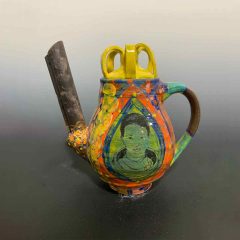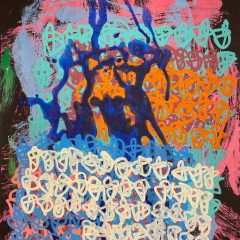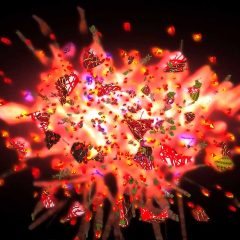The streets may have been deserted, But the few galleries that were opening for First Friday on the July 4th holiday weekend still had a surprising number of attendees, if not exactly major crowds. And since I began at Bambi at the Piazza, everything seemed quite celebratory.
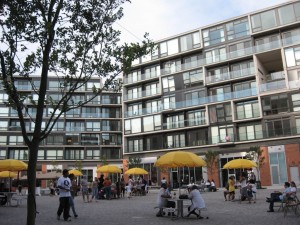
The Piazza was busy enough, and the gallery’s back door and back glass wall on the Piazza joined the interior and the exterior spaces. The Piazza is a breathtaking stretch of open space for an urban setting–big enough to dwarf the Jumbotron! The only thing I disliked about the space was the stage beneath the Jumbotron–a stepped, flat-topped half-pyramid that domineered in an unpleasant way.
Bambi
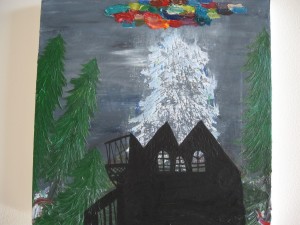
The biggest crowd I saw was at Sarah Gamble‘s opening of her show the Unemployment Paintings, at Bambi, now located at developer Bart Blatstein’s Italian fantasy, the Piazza. Gamble, a recent Pew fellowship recipient, lives in a world where things–houses, weeds and invisible waves are animate. The electromagnetic emanations and encrustations are seductive rainbows against the blue sky, Other things–perhaps computer trash and cell phone trash–have taken up residence amid baroque fields of weeds. Computers emanate a golden igloo of Blue Toothiness. One of her charred black houses–a baroque Victorian with multiple wings and turrets–is also animate, threatening and mournful. These paintings look great, even as their subjects become forces of nature, taking over. The exhibit will remain up to July 26.
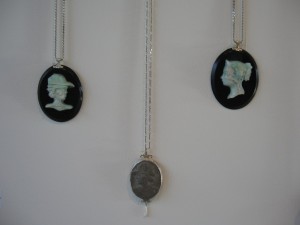
Also at Bambi, which is a boutique as well as a gallery, is some of the best arty merch ever. I adored some giant cameo necklaces made of CDs and vinyl records, by Jennifer Hermann. Hermann also made a bunch of white plastic rings made of orange juice seals that she then embroidered with a sewing machine–also terrific–and reasonably priced (see comments for a correction on this; they only look machine made).
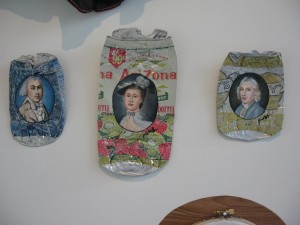
Proprietor Candace Karch also has a number of pieces from previous shows, like the miniature historic portraits Kim Alsbrooks paints on crushed soda cans–her White Trash Family, or like Tory Franklin’s cut-out paper portraits. Plus she borrowed a hilarious Warren Mueller chandelier made from push brooms, and hung it in the back/boutique section of the store. If I had the space for it, I’d find out how to purchase it.
Projects–Summer in the City and more
On my way back toward Center City, I stopped at Projects Gallery for their Summer in the City exhibit, now in its second month. This show is pretty good for an open call sort of thing, and life in the hot city is what its main theme is. And part of what I liked about this show was it didn’t seem to hav an age bias. So there was work by young and old, side by side, and most of it, even if you could tell the artist’s age, seemed pretty terrific.
Among the outstanding work there:
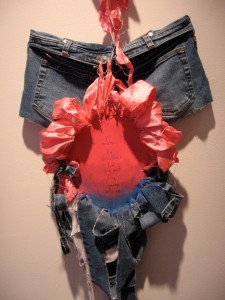
Moore College grad (’07) Aubrie Costello’s pieces from her Philly Hollers series apparently offend the men and delight the ladies according to Projects Associate Director Sequoiah Medley, who sits in the gallery taking in people’s responses (she’s also was a juror of the show). Costello’s installation, with its Lynda Benglis bravado, includes a brief girl’s top, ultra short shorts, and hottie sandals with two giant hot-pink prize ribbons across the cleavage and the crotch. The medusa-like torn and tangled ribbons surround painted messages. The larger ribbon says, “Ya man, He shouldn’t let you out of the house alone.” The smaller one says, “Juicy as Shit.” Costello said she has a notebook filled so far with three years worth of some of the offensive things that men have called out on the street to her and her friends.
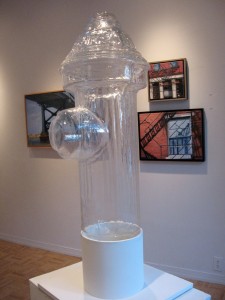
In contrast, Daniel Petraitis’ glass Fire Hydrant on a ring of steel is as cool and male and terse as Costello’s installation is hot and female and gabby. Part of what’s wonderful about Fire Hydrant is the hot processes that created something that looks like a melting ice sculpture. The piece is at once a penis and the source of sidewalk gushers keeping kids cool. It’s a mix of deadpan and glamor, humbleness and grandeur, reminding me of how Olafur Eliasson’s The New York Waterfalls captured the those dichotomies using opposite means (DIY humbleness to suggest grandeur as opposed to vice versa).
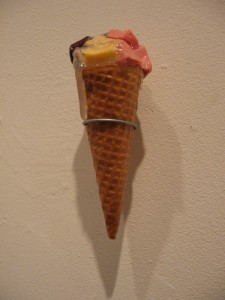
And speaking of hot and cold, Conor Fields’ ice cream cone, Neapolitan, made with a real cone, dried astronaut ice cream and hot glue is wonderfully revolting as it too plays with the contrast between hot and cold.
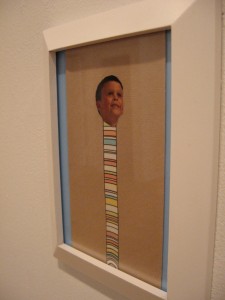
In the 2-D department, I especially enjoyed several gouache and collage pieces by Adam Lovitz, which all have conceptual underpinnings and inexplicable magic in their choices. I especially loved his Candy Abdomen series of saccharine children’s portraits atop a tower candy-colored stripes, looking for all the world like Pez dispensers.
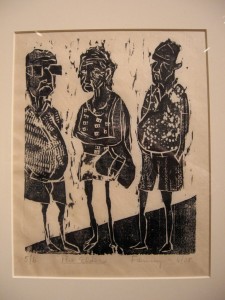
In dramatic contrast to Lovitz, some black and white woodcuts by Fay Stanford look to elderly people–two women arguing in the pool lanes, and three grumps atop their skinny legs, looking like indignant storks. The wit and sharp observation in Stanford’s cartooning crosses generational barriers.
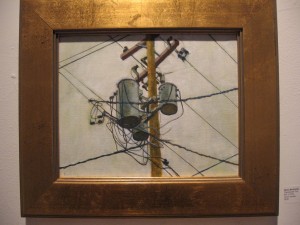
I also liked the pairing of Henry Berkowitz’s traditional oil-on-canvas skyscape of transformers and wires, which is the most youthful of his pieces, in terms of subject matter, and the vignette of urban life in Jennifer Baker’s oil on mylar Wedding Party, which, youthful though it is in its handling of imagery, can also pass for quite old except for the mylar.
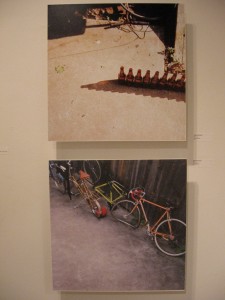
A couple of photos by Tamsen Wojtanowski caught my eye. I liked the raking angles of the compositions and the content–a lineup of beer bottles casting long shadows on the sidewalk, and a lineup of crippled bicycles. Both photos not only capture the sorts of things we normally avert our eyes from, but also capture things as representations of people, worn and hurt by a tough life in the city.
Others in the exhibit are Linda Dubin Garfield, Ashley Flynn, Bobby Rosenstock, Martha Savery, Allen Spencer and Deborah Imler, Jayne Surrena, Mat Tomezsko, and Andrew Wapinski.
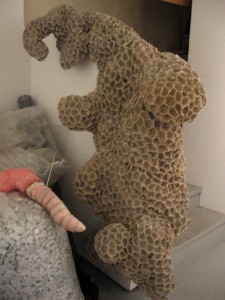
While I was there, Medley took me downstairs to look at an installation in progress by Lisa Murch. The sewn egg crate bottoms are pretty amazing!Murch will be down there off and on during the summer growing the piece, and would welcome people to stop by and give her feedback as she works. As of now, there’s no set schedule, but you could probably call the gallery and see if you can pin down a sure time.
Tiger Strikes Asteroid–Andrew Prayzner and William Crump
Manifest Destination was the perfect July 4th experience, with its questions about the American dreams of success and a limitless frontier.
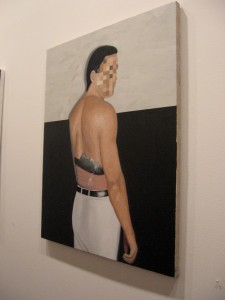
Prayzner, an ex-Philly guy who has moved to Brooklyn, is showing six oil paintings that appropriate police photos of Colombian drug mules. The images of half-stripped bodies taped with drugs or with drugs packed into underclothes are depressing and degrading–the baggage deforming the bodies in weird ways. The pixelated grid covering the faces strips the mules of their identity and places them in some sort of meta world of those who don’t deserve to be seen because they are bad.
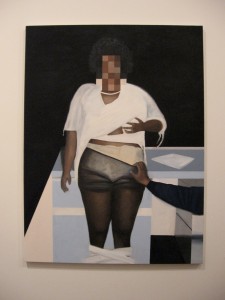
Yet they look vulnerable, vulnerable enough to elicit a load of empathy–people who underestimated the risk of what they were doing and were pawns of a larger cultural and economic system, entrapped by the poverty of their lives and an oppressive legal system that seems a little crazed on this subject of drugs.
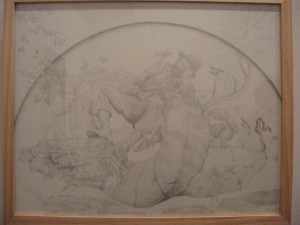
While we’re on the subject of the land of the brave and the free, New York artist William Crump‘s beautiful drawings of the American landscape populated by lonesome frontiersmen–cowboys, trappers, mountain men, and a voluptuous nude of a mountain man’s wife–are distanced from their references to historic magazine images of the great frontier by discordant elements like rainbow creeks and auras. These images at once capture the majesty of Ansel Adams’ Yosemite photos and reflect on the story the nation told itself about the push Westward.
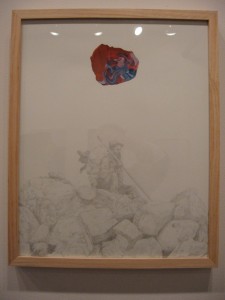
Crump uses what I take to be a very hard graphite pencil, to which he ads gouache or colored pencil in some cases. The paleness of the drawings not only pull you in close, but they suggest a fading, a loss of power and a loss of memory. The colors are dreamy elements, the last drippy drop of romanticism still flowing, or even orbiting threats.
The work is beautiful and sad, the fireworks of an era undercut by a more cynical view.
All three exhibits, using largely traditional media in four-square formats, still manage to find new ways to see. On this moment of our nation’s birthday, I saw a loss of optimism, and a sadder definition of what it means to be American. I suppose that’s not surprise, given the economy, the draining of American power and leadership, and the loss of moral high ground perpetrated by the last administration (I can’t even write that man’s name).



